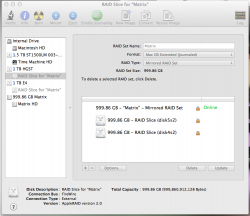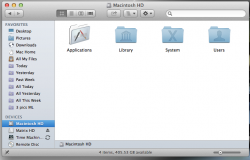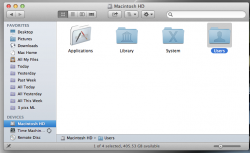I have 2x G-Drives Firewire 800 drives in Raid 1 (daisy-chained), as you can see in Disk Utility, Pic 1. Then, Pic 2 shows the drive in the Finder, I named it Matrix HD, homage to Intel matrix storage. Now, I am told by the internet that this offers some kind of security in case of drive failure. Well, today I disconected one of the Raid drives, and I was hoping my data would still be acessible and perhaps get some warning at disk utility. But instead, EVERYTHING WENT MISSING. Even tough I had one of the Raid 1 drives conected to the Mac, there was nothing to see in the Finder or Disk Utility. So how the hell this offers security? The array got broken. In case of a real drive failure, Im gonna lose all my data.
Become a MacRumors Supporter for $50/year with no ads, ability to filter front page stories, and private forums.
Raid 1 on external HDD, is a myth?
- Thread starter LeandrodaFL
- Start date
- Sort by reaction score
You are using an out of date browser. It may not display this or other websites correctly.
You should upgrade or use an alternative browser.
You should upgrade or use an alternative browser.
If the drive is connected directly to the Mac, powered, but not showing anything in Disk Utility, (i.e. not even the hardware drive, as opposed to the partitioned volume on that hardware) then that might point to a hardware failure of the drive itself.
This might be coincidental to splitting the RAID, or possibly a consequence.
Does the drive show up in System Report > Firewire?
What happens if you connect only the other drive from the RAID? Do you get the same result?
And if you re-unite the pair? Is it all working again?
This might be coincidental to splitting the RAID, or possibly a consequence.
Does the drive show up in System Report > Firewire?
What happens if you connect only the other drive from the RAID? Do you get the same result?
And if you re-unite the pair? Is it all working again?
And if you re-unite the pair? Is it all working again?
If I reunite the pair, its all working again, but I wonder what is the point of RAID 1, as appaarently, if there is 1 drive failure, you lose both data
You're sure that the drive was connected directly and powered up? It's very odd that Disk Utility did not even show the hardware drive, in order to allow erasing/re-partitioning.
I'm no expert on RAID, but perhaps a RAID-ed volume always expects to be one of a pair? Perhaps you need to add another new mirror to the RAID set before things will work as normal. This is nothing more than a pure hunch.
It's worth asking: do you actually need RAID 1? It is usually used for particular circumstances, usually "mission critical" server stuff.
Any reason why a simple backup isn't good enough -- be it Time Machine, Retrospect, CarbonCopyCloner, Chronosync, etc, etc...?
I'm no expert on RAID, but perhaps a RAID-ed volume always expects to be one of a pair? Perhaps you need to add another new mirror to the RAID set before things will work as normal. This is nothing more than a pure hunch.
It's worth asking: do you actually need RAID 1? It is usually used for particular circumstances, usually "mission critical" server stuff.
Any reason why a simple backup isn't good enough -- be it Time Machine, Retrospect, CarbonCopyCloner, Chronosync, etc, etc...?
You're sure that the drive was connected directly and powered up? It's very odd that Disk Utility did not even show the hardware drive, in order to allow erasing/re-partitioning.
I'm no expert on RAID, but perhaps a RAID-ed volume always expects to be one of a pair? Perhaps you need to add another new mirror to the RAID set before things will work as normal. This is nothing more than a pure hunch.
It's worth asking: do you actually need RAID 1? It is usually used for particular circumstances, usually "mission critical" server stuff.
Any reason why a simple backup isn't good enough -- be it Time Machine, Retrospect, CarbonCopyCloner, Chronosync, etc, etc...?
I did another test today, and it appeared.
The first time, I disconected the cable of the 2n hard drive, but let it connected to the first (the drives are daisy chained), and of course, the first drive was connected to the Mac
This time I disconnected the cable from the first drive instead, while letting the first drive connected to the Mac. This way, itshows fine in the Finder and I can acess my files.
I check all these bakcup options and none satisfy me.
I did another test today, and it appeared.
The first time, I disconected the cable of the 2n hard drive, but let it connected to the first (the drives are daisy chained), and of course, the first drive was connected to the Mac
This time I disconnected the cable from the first drive instead, while letting the first drive connected to the Mac. This way, itshows fine in the Finder and I can acess my files.
I check all these bakcup options and none satisfy me.
RAID is not a backup option. That cannot be stressed enough.
RAID is not a backup option. That cannot be stressed enough.
Anwer me this, Can I take a Time Machine backup and connect to a diferent Mac (diferent model, diferent year) and can this new Mac acess the data from the Time Machine Backup?
Im not asking regarding a complete system restore, I just want to know if I can manually acess videos, photos and documents and manually copy them over.
Anwer me this, Can I take a Time Machine backup and connect to a diferent Mac (diferent model, diferent year) and can this new Mac acess the data from the Time Machine Backup?
Im not asking regarding a complete system restore, I just want to know if I can manually acess videos, photos and documents and manually copy them over.
Yes, you can present a Time Machine volume as just another HFS+ volume to another Mac. From there, you can navigate into the Backups.backupsdb folder and copy files from a specific snapshot. However, do not attempt to remove files from the backups. Time Machine uses hard links on directories and files for each snapshot in order to present a complete filesystem without having to actually replicate data. If you remove a file from one snapshot, that can impact the integrity of many other snapshots.
Time Machine uses hard links on directories and files for each snapshot in order to present a complete filesystem without having to actually replicate data. If you remove a file from one snapshot, that can impact the integrity of many other snapshots.
Deleting the files may be bad for various reasons, but this isn't one of them. Think of a hard-linked file as the same file with multiple directory entries. If you remove the file out of one directory, the same underlying data is still there. The data won't go away until the hard-link count goes to zero. Those are Unix filesystem semantics.
Deleting the files may be bad for various reasons, but this isn't one of them. Think of a hard-linked file as the same file with multiple directory entries. If you remove the file out of one directory, the same underlying data is still there. The data won't go away until the hard-link count goes to zero. Those are Unix filesystem semantics.
The difficulty in this situation comes with removing directories. While directories in a Time Machine volume may have multiple hard links, their underlying objects may or may not. If one were to try to remove one of these hard-linked directories in a standard fasion, such as "rm -r", this would unlink and delete underlying objects which may appear in numerous snapshots. This means that what appears to be removing a folder from a later snapshot could delete objects in other snapshots.
The reason this isn't working as you think it should is because you are disconnecting the enclosure and the HDD within. In a HDD failure situation the enclosure is still attached but can't read the drive. Place a new HDD in the enclosure and it should rebuild the array. However, when you disconnect the enclosure you are removing hardware that has no redundancy. Thus the broken array as it can't detect the missing/failed HDD.
Wait... You made a RAID with two separate external Firewire drives?
Oh god I would not trust that at all. Software RAIDs (what you had) are not as secure or stable as Hardware RAIDs. I have had a few problems with them and refuse to use them again.
Yeah...but its RAid 1....its better then not having anything...
Yeah...but its RAid 1....its better then not having anything...
That depends on what your goal is. The fundamental purpose of RAID is to ensure that data is always online, irrespective of how reliable hardware is. Given a likelyhood that a physical disk can fail, RAID ensures that the likelyhood that the logical volume fails as well is lower. This can extend to block-level or byte-level depending on the configuration.
If the goal is to prevent against data loss, then a backup solution is warranted. A good backup solution works by tracking changes to files, and keeping a history of those changes. This offers protection from runaway processes, human error, or even environmental distaster (via off-site backups); RAID cannot protect you from this.
Anwer me this, Can I take a Time Machine backup and connect to a diferent Mac (diferent model, diferent year) and can this new Mac acess the data from the Time Machine Backup?
Im not asking regarding a complete system restore, I just want to know if I can manually acess videos, photos and documents and manually copy them over.
Use the Time Machine app's "Browse Other TimeMachine Disks" feature on the other Mac. You then can use the normal TM interface to find the relevant date and file you need.
Register on MacRumors! This sidebar will go away, and you'll see fewer ads.




